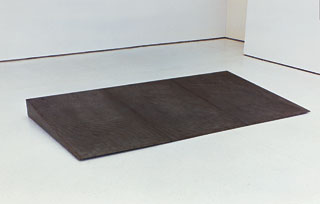|
| |
 |
|



|

Untitled, 1968. Perforated 12-gauge cold-rolled steel, 8 x 120 x 66 inches. Solomon R. Guggenheim Museum, New York, Panza Collection. 91.3712
|

In the early 1960s Donald Judd abandoned painting, having recognized that "actual space is intrinsically more powerful and specific than paint on a flat surface." His move into three dimensions coincided with a growing acknowledgment among other artists of his generation of the physical environment as an integral aspect of an artwork. Minimalist sculpture broke with illusionistic conventions by translating compositional concerns into three dimensions, rendering the work a product of the exchange between the object, the viewer, and the environment.
In his 1965 treatise "Specific Objects," Judd championed recent work that was neither painting nor sculpture by a diverse range of artists. His endorsement of "the thing as a whole" rather than a composition of parts stemmed from what he saw as the strength and clarity asserted by singular forms, the unitary character of which resulted from the conflation of color, image, shape, and surface. Judd's earliest freestanding sculptures were singular, boxlike forms constructed of wood or metal. The simple, wedge shape of Untitled (1968) is readily intelligible as a whole and thus avoids the compositional effects that for Judd diluted a work's power. As the artist's exploration of three-dimensional space became more complex, his aversion to such effects was manifested in a number of strategies designed to subordinate a work's individual components to the whole.
Like the rectangular shape with which he began, Judd's stacks and rows are legible systems that recur in his oeuvre. In its repetition of serial forms and spaces, the vertical stack of Untitled (1969) literally incorporates space as one of its materials along with highly polished copper, creating a play between positive and negative that coheres as a totality. Untitled (1973) applies a similar structuring of space to a horizontal format. The opaque, reflective brass tops, fronts, and bottoms and translucent, red Plexiglas sides of the individual boxes produce a luminous effect. True to Judd's renunciation of illusionism, color and surface quality are not artificially simulated through the application of paint, but are inherent to the materials themselves.
|
|